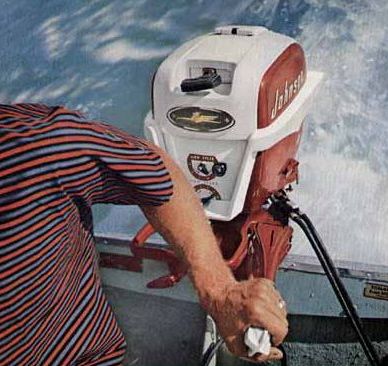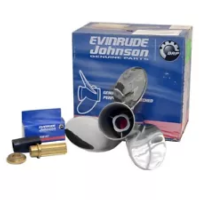The motor for this project is Model CD-15 Serial 1698561.
Johnson CD-15:
Year: 1958
HP: 5.5
WOT RPMS: 4000
Displacement: 8.84 cu.in. = 144.8 ccm
Weight: 56 lbs. = 25.4 Kg
Gearcase Ratio: 15:26
Spark plugs: Champion J6C gapped at .030" (Same as Lightwin)
Fuel/Oil mix: 24:1 87 octane gas to TC-W3 rated outboard oil.
Lower unit oil: 80/90W / OMC/BRP HiVis.
A Warning About Pressurized Fuel Tanks
These motors use pressurized fuel tanks. Rather than sucking fuel from the tank, the dual line hose pumps air into the tank, pressurizing it to 4-7 PSI which forces fuel back to the motor. Basically, these pressurized tanks are an extremely dangerous fire or explosion danger. CLICK HERE to learn more about these tanks and how to convert to the newer and safer fuel tanks.
Time to get Started - If you have gas in the tank, you might as well go ahead and try to start your motor. There is not much point in this except to get a feeling for how much things improved when you are done. Before you start it up, stick the lower unit in a garbage can full of water. Note how well the motor turns over and if the recoil starter is working. Also, note if the motor seems to have good compression. Inspect the rope and handle to see if they need to be replaced.
As I disassemble this motor, I plan to clean up everything I can with a cloth and spray cleaner. There are many special cleaners available for this but I am simply using common household CLOROX Clean-UP Cleaner with Bleach which I found under the sink. Hopefully, I will return it before my wife discovers it missing. I also plan to keep these parts organized as I take them apart.
Take off the Motor Covers
CLICK HERE for details.
The major areas that we will focus on are Powerhead, Fuel/Carburetor, Ignition, Impeller and Lower Unit Lubricant.
Power Head
Before you decide to tune-up your motor, you want to make sure that the motor will turn over and you have compression with both cylinders. If the motor will not turn over by turning the flywheel or it does not seem to have compression, then your motor needs more than a simple tune-up. You will have to decide how badly you want to fix your motor and how far your mechanical ability will take you. A tune-up is fairly easy. Freeing pistons and restoring compression is more on the medium level of difficulty and beyond the scope of this article. I do not want to say that the motor cannot be fixed or is not worth fixing but with the motor that I am using for this article, it is not necessary. In another article, I did have to free the pistons on a Johnson 15 HP motor and give it a new life. You can get a compression gauge at your local auto parts store for around $20 or $30. The compression should test out to be at least 85 or 90 pounds but probably less than 100 psi.
You may want to replace the starter rope and/or the starter rope handle. It is also possible to replace the starter recoil spring if necessary. All these parts are still available but were not necessary for this project.
Remove and replace the head gasket.
CLICK HERE to read about servicing the cylinder head.
Carburetor
Anytime you have an old motor that sat around for a while, you can assume that the carburetor needs service. Gas, especially when mixed with oil will turn to varnish or otherwise gum up your carburetor. While there are many carburetor cleaning additives that you can put in your fuel tank or spray directly into the carburetor, they will not come close to accomplishing the same thing as a carburetor tune-up. Even if the motor was stored without fuel in the carburetor, the gaskets may dry out and crack or quickly deteriorate once you try to use it again. The only way to make sure the carburetor is going to function well is to remove, disassemble, clean, and reassemble with new parts, replace, and make adjustments which are the steps to performing a carburetor tune-up. CLICK HERE for detailed photographs and procedures for performing the carburetor tune-up for this motor.
Ignition System
With the exception of the spark plugs and plug wires, all of the ignition system is located under the flywheel. The type of magneto ignition on this motor is Flywheel Magneto with Breaker Points. The job of the ignition system is to generate enough voltage (around 20,000 volts) to jump the gap on the spark plugs creating a spark and and igniting the fuel/air mixture, and to make sure that voltage is delivered to the spark plug with exactly the right timing CLICK HERE for detailed photographs and procedures for performing the ignition system tune-up for this motor.
Impeller and Lower Unit
It is always a good idea to replace the impeller. The impeller is one of the most critical parts of the motor because it fails, you can easily burn the motor up, warp the head, or have other major problems. CLICK HERE for detailed photographs and procedure for replacing the impeller water pump and servicing the lower unit.






